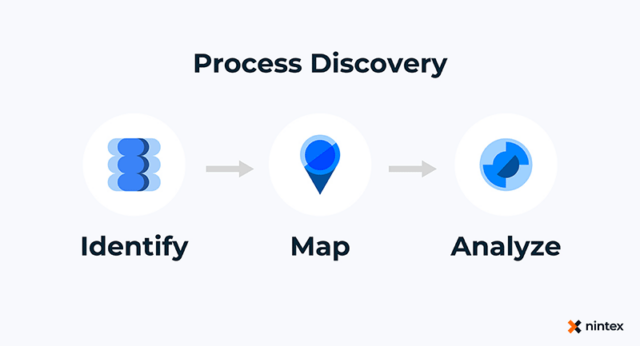Without process discovery in your toolkit, understanding how work gets done in your business can be an impossible task.
Process discovery is a systematic way to identify, map, and analyze business processes. With traditional methods posing several challenges, AI-based solutions have emerged. These AI tools, known as ‘process discovery’ or ‘task mining’, capture user data and autonomously identify and map processes, offering a data-driven approach. This is crucial for any process improvement or automation effort, helping businesses gain a thorough understanding of their current processes.
Process Discovery definition
The term “process discovery” refers to a set of tools that help identify, map, define, and analyze business processes and the tasks they involve. Discovery is a key step in process improvement or automation, as businesses need a clear understanding of their current workflows before implementing changes.

Manual Business Process Discovery
Traditionally, process discovery methods have included:
- Anecdotal interviews with end users
- Observing employees perform work
- Conducting focus groups
- Whiteboarding
- Manual data collection and analysis
While these traditional methods can offer insights, they are time-consuming and subjective, often leading to incomplete or inaccurate documentation. These challenges can delay automation efforts and hinder process improvements.
Automated Business Process Discovery
Recent technological advancements have automated the process discovery phase with AI-based solutions, also known as “process discovery” or “task mining.” These tools automatically capture user data, identify recurring workflows, and map them, offering businesses real-time insights to drive automation.
Process Capture.
While traditional process discovery focuses on mapping workflows through AI, Nintex Process Capture takes the next step by helping businesses document, standardize, and optimize those processes for ongoing use. Unlike pure discovery tools, Nintex Process Capture ensures that businesses can continue refining workflows as they scale and evolve. It combines the automation benefits of AI with a user-friendly interface for manual adjustments, making it ideal for mid-market businesses that need ongoing, adaptable process management.
What’s the Difference Between Process Mining, Process Discovery, and Process Capture?
- Process Mining uses system data (like event logs) to provide high-level insights, identifying process inefficiencies.
- Process Discovery focuses on uncovering and mapping workflows using AI to track user behavior, often capturing granular details. However, it can be limited when it comes to continuously refining processes for scalability.
- Process Capture, in contrast, not only discovers workflows but also enables ongoing documentation and refinement, ensuring processes stay aligned with business needs as they evolve. This makes Nintex Process Capture a perfect solution for mid-market businesses looking to document, improve, and scale their workflows consistently.
Why is Process Discovery important?
Businesses use process discovery to address challenges like:
- Reducing costs
- Enhancing employee experience
- Filling gaps caused by turnover
- Adapting to remote work
Process discovery is the starting point for any improvement or automation project. It helps organizations identify and document their current processes, setting the stage for more efficient operations. However, for mid-market businesses looking for ongoing process improvement, Nintex Process Capture provides the added advantage of continual process documentation, ensuring that businesses can scale with confidence and efficiency.
How does Process Discovery work?
Process discovery tools track user activities and generate maps of workflows. The output typically includes process flowcharts, automation recommendations, and process definitions. Nintex Process Capture capability takes this even one step further by enabling businesses to not only discover processes but also refine them with ongoing input from employees and process owners, ensuring continuous process optimization.
Examples of process discovery
- Accelerating Process Documentation: Process Discovery speeds up the documentation of processes by generating Process Design Documents that can be standardized across the organization. Nintex Process Capture improves this by allowing businesses to update and optimize these documents over time.
- Identifying What to Automate : Process Discovery helps identify which workflows are ideal candidates for automation. Nintex Process Capture allows businesses to continue capturing process changes, ensuring that automation initiatives stay relevant and aligned with evolving business needs.
What should organizations consider when looking at Process Discovery tools?
While process discovery is vital for understanding current workflows, mid-market businesses should look for tools like Nintex Process Capture that go beyond mapping and help standardize, refine, and adapt processes for the future. By offering both discovery and continuous process management, Nintex Process Capture is the most scalable, adaptable solution for ongoing process improvement.
At Nintex, we are process and automation experts who specialize in enabling companies to drive transformation and deliver better customer and employee experiences. We empower business users to create end-to-end solutions with an ecosystem of powerful but easy-to-use tools including Nintex Process Manager, Automation Cloud, RPA, DocGen, and eSign. Learn more about Nintex Process Platform here.
See how you can start discovering and capturing your processes faster with AI here with Nintex Process Manager.
